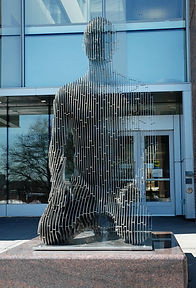[SLIPPAGE] no. 3 | summer 2014 | THE CONFLUENCE OF SCIENCE AND ART
'Spannungsfeld' (2014), by Julian Voss-Andreae
Julian Voss-Andreae's sculptural installation "Spannungsfeld" for the University of Minnesota’s new Physics and Nanotechnology Building was inspired by a view of the human body through the lens of quantum physics.
The German title of the installation (literally, "tension field") originated in physics, but is used in contemporary German almost exclusively in a metaphorical sense. It implies a dynamic tension - often between polar opposites - that permeates everything in its vicinity.
"Spannungsfeld" is made up of two 10' (3 m) tall figures in a basic kneeling pose, a male and a female, facing each other. The two figures represent nature’s omnipresent pairs of opposites. These dualities are a fundamental facet of nature and are found in Western science as well as in Eastern traditions. They are critical to the emergence of new levels of meaning in science, and, in the case of the two human genders, critical to the emergence of life. Like the positive and negative electric charge in physics or the yin-yang in Chinese philosophy, neither woman nor man can exist without the other.
Inspired by his background in quantum physics, Voss-Andreae developed an approach that transforms the human figure into a large number of vertically arranged, parallel steel slices with constant spacing. This style creates the impression of a three-dimensional topological map, evoking the fundamental scientific act of measuring the world. The visual effect this style produces is striking and echoes quantum physics' paradoxical nature, as well as its critical dependence on the observer's point of view. On first glance, they appear to consist of solid steel, but the sculptures virtually disappear as the viewer moves past them, enticing the audience to interact playfully with these works. Conceptually, it is the very act of analysis through dissection that reveals the interconnectedness of the figures, as both sets of slices comprising the figures fall on the exact same planes and therefore appear as a continuation of each other and as manifestations of the same underlying 'field'. As quantum physics suggests - and as Eastern traditions have stressed for centuries - the world is fundamentally one, that is, everything and everybody we see is but a manifestation of an underlying wholeness. As in the history of science leading up to quantum physics, the application of the reductionist knife eventually forced us to see that nature is indivisible.




